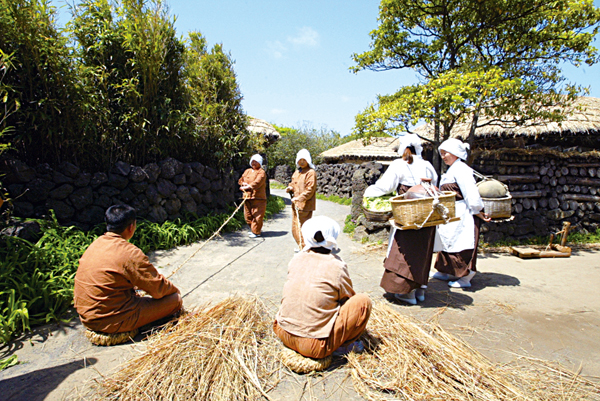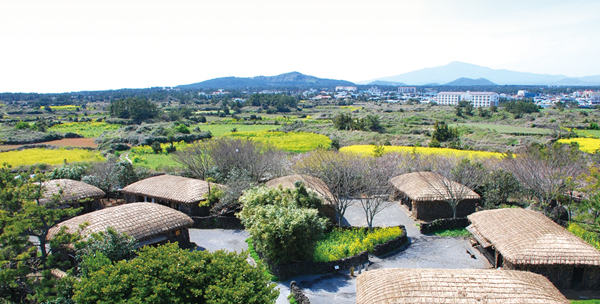| |
 |
|
| ▲ Three folk performances are put on per day at the Jeju Folk Village in Pyoseon. Photos courtesy Jeju Folk Village |
[This is a paid advertisement from the Jeju Folk Village - Ed.]
Despite expectations, there is little museum-like about the relocated and restored villages on 157,000 square meters of Pyoseon land at Jeju Folk Village. In fact, it is much more like a country stroll, along an “olle,” even.
Within walking distance of Pyoseon Haevichi Beach and near the Haevichi hotel & resort itself, this is a must-see for anyone looking for a hands-on historical and cultural experience. Founded in February 1987, the some 100 structures were painstakingly brought rock by rock from across the province to represent traditional structures representative of the Joseon era (1392-1910).
Don’t be fooled by the village in the title either, a slight misnomer. The site is vast with wending and winding paths which guide you through relocated villages whose styles, adapted to geography, climate and function, attest to their geographic origins.
A tour through Jeju’s not-so-long-lost past
“These houses are exactly as my house was where I grew up in Gwakji,” a coastal region in Aewol-eup where manager Yang Jin-seok was raised. “We have many items from Aewol as they are most representative of the western styles; we also have many items from eastern areas such as Pyoseon, as they represent the east,” Yang continued.
The east-west split is a feature of Jeju culture as geography, weather and agricultural conditions fostered divergence. The east-west axis, however, is arguably not most defining of Jeju culture, as it is altitude that has most strongly influenced foods, housing and social relations.
If one were to ascend the slopes of Mt. Hallasan prior to Park Chung-hee’s New Community Move-ment in the 1970s, which “modernized” rural communities, you would notice that Jeju coastal villages contrast with mid-mountain villages, which contrast again with upland settlements. All are introduced here in turn, in addition to a market area, a shamanic village and administrative structures of the period.
Although the differences in architectural styles are hard to detect, I had help at hand. As we entered a well-to-do mid-mountain settlement my attention was brought to the bamboo across the door frame: “That ensures that people entering lower their heads to the upper classes inside,” Yang said.
I learn that such mid-mountain villages - in the region known as the “jungsangan” - were the most prosperous in the Joseon era and came under the most Confucian influence due to “yangban,” or literati culture. These villagers also enjoyed higher crop yields and had the luxury of traditional medicine stockists, absent in coastal regions where matriarchal haenyeo culture held more sway.
I also learn of the hardier side of local life including the - by necessity - waste-not-want-not lifestyle which included fertilizing crops with fermented urine from the “ujumhang” (urine pot) and feeding Jeju’s black pigs with the family’s excrement from the “tongsi.” I wondered which of my habits tourists of the future might scoff at as they tour a recreated London terrace of the late-20th century.
| |
 |
|
| ▲ Jeju Folk Village covers 157,000 square meters and represents all of the island's cultural influences. Photos courtesy Jeju Folk Village |
The Jeju Folk Village difference
The Jeju Folk Village’s difference is in its attention to detail. Many aspects of Jeju culture can be learned about elsewhere, such as the three-poled Jeju gate (“jeongnang”), both protecting garden crops from animals and also signaling when the owner will return, to the original “olle,” or winding house-to-house paths which provide both shelter and privacy.
But visitors also learn about the indigenous “gudeok,” a portable reed cot in which Jeju mothers kept babies while working the fields or at home, the “seompi,” a rake for smoothing down the soil, and the “maemdol,” a rock used to tether cattle, among much, much more.
There are plenty of other recreated Jeju villages across the island and some are in far more picturesque locations. However, Jeju Folk Village is surely the most in-depth, educational and wide-ranging of them all.
It is no surprise, then, that 13 films and dramas have so far chosen Jeju Folk Village for filming including Jewel in the Palace, The Slave Hunters, Merchant Kim Mandeok and Tamna the Island. Throughout the site there are signs to point out which was filmed where, evidently a point of great interest for tourists from across East Asia.
Handily, the market area toward the end of the circuit - again, in recreated period structures - contains the snack bars, restaurants and souvenir shops. The expected fare of Korean pancakes or stews looked pretty good, although I opted for the “yeot,” or traditional nougat, after seeing it being prepared before my eyes.
Also of great convenience for non-Koreans are the audio guides that can be taken on the tour. Visitors are given a pamphlet on which each exhibit is numbered and by pressing each number with the handset, visitors can receive commentary in English, Japanese or Chinese.
The guided tour took a little over 2 hours but I would say an hour either side of that is also possible. You could even spend half a day there, with three daily folk performances and even traditional handicraft exhibitions where visitors can purchase souvenirs.
I would certainly go again and I now have the perfect answer to that perennial question: “Where should I take my mother on her next visit to Jeju?”
Jeju Folk Village
631-34 Minsokhaean-ro Pyoseon-myeon, Seogwipo City
8:30 a.m. - 5/5:30/6/6:30 p.m. (Closure varies through the year). Open all year.
Adults: 9,000 won, students: 6,000 won, children: 4,500 won, senior citizens: 4,500 won
Jeju Intercity Bus Terminal → #720 (toward Pyoseon) → Jeju Folk Village [1.5 hours] → walk [2 mins]
Call +82-64-787-4501 or visit eng.jejufolk.com
|





















